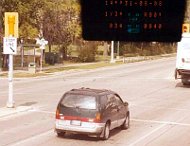4/2/2009
Winnipeg, Canada Caught Trapping Drivers with Short YellowsShortened yellow timing may have helped Winnipeg, Canada increase ticketing revenue 23 percent in 2008.

The city of Winnipeg, Canada has shortened the duration of the yellow warning at intersections equipped with red light cameras. The length of the yellow is the single most important factor in determining the financial success of a photo enforcement program, according to documents obtained from a red light camera vendor in 2001 (view documents). Winnipeg's shortening has yielded positive financial results.
The city's signal changes came to light after a 64-year-old grandmother named Judy received a ticket in the mail claiming her minivan had run a red light on August 31, 2008. She contacted Larry Stefanuik, a former police constable who now helps motorists fight traffic tickets who began looking into the ticket. Judy's ticket shows the intersection had been set with a 3.9 second yellow and that she entered the intersection -- slowly -- just 0.1 seconds after the light turned red.
That did not match the city's stated policy of setting the yellow warning to last at least 4.0 seconds at every intersection (view email), according to an email obtained by Stefanuik.
"So in reality she had not run the red because it still should have been yellow," Stefanuik said. "Her speed was 49km/h in a 60km/h zone [30 MPH in a 37 zone]. She was robbed of 1/10th of a second."
The local court was not interested in exploring whether the city had violated its own policies by shortening the yellow. On March 18, the court imposed a $135 CAD fine on Judy, reduced from the standard $190 fine.
These fines have been adding up at the red light camera intersection in question. By 2007 the camera had issued 173 tickets, but by 2008 it was on track to issue 324 -- an 87 percent increase. The majority of the red light camera intersections in Winnipeg have seen a similar increase in tickets issued that helped drive an overall ticketing increase in the city of 23 percent.


